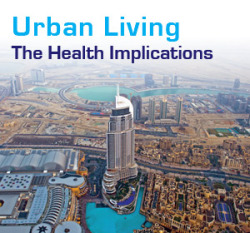April 7 marks World Health Day, with the theme for this year’s annual awareness being urbanisation and health
Urban Living
The Healthy Imlications
Living in a city environment poses its own unique set of challenges for maintaining good health, something that the World Health Organization (WHO) is addressing on April 7. The date marks World Health Day 2010, with the theme for this year’s international awareness initiative being urbanisation and wellbeing. Under the slogan ‘1000 cities-1000 lives,’ WHO is calling for metropolitan centres across the globe to open up their streets for various health-related activities; such as the banning of motorised transport for the day, or the cleaning up of urban spaces that have been bespoiled by litter. The day’s programme was chosen to highlight the potential health problems associated with the increasing trend towards living in cities; a trend that was highlighted by the United Nations (UN) at the beginning of 2008, when the organisation projected that half of the world’s population would be living in urban areas by that year’s end. A more recent UN report published just weeks ago concluded that the world’s largest cities are becoming ‘mega regions’ that will be defined by overcrowding, poverty and pollution. The organisation said that the continuing growth of urban areas is likely to be one of the most significant factors affecting society over the next 50 years.
Dr Suresh Menon, a specialist in internal medicine at Jebel Ali Hospital, Dubai, agrees that this year’s focus for World Health Day is both timely and important. “Past research has documented a difference between urban and rural health care, usually expressed in terms of healthcare access and utilisation, its cost and the geographic distribution of providers and services,” he says. “Recently, research has begun to direct its attention toward the differences in population health, public health, environmental health and between urban and rural health behaviour. This focus on the environmental and social determinants of health has accompanied a rapid change in rates of urban populations across the world. As more people worldwide live in cities, it is imperative to understand how urban living affects population health,” he adds.
If any example graphically represents the concept of rapid city growth, it is that of Dubai. The city has witnessed an explosion in its population over the past 20 years, largely as a result of the government’s decision to diversify from an economy based around oil and trade to one that is service and tourism-oriented. This decision made real estate and other developments more valuable, resulting in a property boom and a level of construction that has seen an estimated 25 per cent of the world’s cranes being utilised for projects within the emirate. Dubai has become one of the fastest-growing cities in the world and although its rate of growth has inevitably slowed following the global economic downturn, the destination remains a popular attraction to live and work, with the recession not impacting here as significantly as elsewhere. As was widely reported in the news last month, Dubai’s population grew 7.6 per cent last year, according to the Dubai Statistics Centre. The body revealed that the number of people living in the emirate rose from 1.65 million to 1.77 million at the end of 2008, with adults and families continuing to relocate to the emirate. Many of these come from rural areas and their perception of greater opportunities and an improved quality of life is driving them to make the decision. The pattern is one that can be seen at major conurbations across the world, with increasing numbers of migrants seemingly attracted by the notion of ‘Bright Lights, Big City.’
“Quality of life is one of the central issues to consider in any comparison between rural versus urban living. While a case can be made for either location as being the best place to live, it is worthwhile to consider the options,” says Dr Menon. “Important factors such as the capacity to make general choices, diversity, health, and employment concerns all influence both sides of the comparison and although both rural and urban living offer great benefits, they both have a seemingly equal number of drawbacks,” he adds.
With regards to the provision of healthcare, there is no doubt that there is an inequality in the delivery of this important service between rural and city regions, but this isn’t a simple delineation along lines of urbanisation. Individuals choosing to move to a city from a rural area will have better access to choices in healthcare and if they experience illness, they will have an increased number of specialists to choose from. However, this isn’t a choice necessarily available to all strata of society. Persons of a lower socio-economic status living in urban areas are more likely to lack health insurance and are more likely to face barriers to care. When they do access a service, it is likely to be of a poorer standard. The high prevalence of individuals without health insurance creates a greater burden on available systems and often leads to vast disparities in health care outcomes.
“Often, a two-tier health care system is created in an urban environment, which sees insured individuals having access to preventive and routine health care, while marginalised sectors of society find themselves using hospital emergency rooms as a safety net,” says Dr Menon. “In the developing world, urban dwellers often live in large slums which lack basic sanitation and utilities, such as water and electricity. This lack of basic infrastructure can exacerbate rates of infectious disease and further perpetuate the cycle of poverty,” he continues.
Parents thinking of moving to a city have the additional responsibilities of the wellbeing of their children to consider. An urban setting may offer a greater choice in public and private schools, which leads to the potential for better education, but the environment may also throw up certain health challenges for these younger members of the family. Dr Arwa Nasir, a consultant paediatrician at Tawam Hospital, Abu Dhabi, who has a special interest in behavioural and developmental paediatrics, outlines some of the issues.
“In built up cities, little open space is available for outdoor play and physical activity. Appropriate levels of physical activity are crucial to maintaining good physical and mental health. Low levels of physical activity contribute to many health conditions such as diabetes, vascular disease and depression,” she says. Dr Nasir is keen to stress that although there may be potentially negative health aspects to city living, these can easily be countered. “Parents can model physical activity for their children by taking them to the gym or park, long walks on the beach or corniche, or other joint sports activities such as biking, hiking, boating, soccer and other sports. Performing household chores can be a good source of physical activity that families can do together and has the advantage of teaching cooperation and contribution to the family as well as building responsibility,” she advises.
The increased levels of stress that can characterise life in a busy city often result from long working hours, being struck in traffic and being exposed to higher levels of crime (although the latter is thankfully not a major issue in the UAE). However, the higher prevalence of psychological stressors that accompany the increased density and diversity of cities may lead to depression, anxiety and other psychosomatic ailments. Longer working hours and lengthier commute times can mean that families in particular suffer in the city. “Busy parents return home after long hours of work with little energy and patience and with diminished ability to spend quality time with their children,” says Dr Nasir. “Also, long working hours may increase the time children are left unsupervised or under the supervision of household help who have no authority over the children, especially older ones. This deprives parents and children from opportunities to communicate and connect with their children. Parents should plan quality time with their children to get to know them well and know what is going on in their lives. This allows the parents to discover problems early as well as build a trusting relationship with their children and experience the joys of parenthood,” she advises.
On the whole, the continuing trend towards city dwelling is resulting in falling birth and death rates, with a shift in the burden of illness from acute childhood infections to chronic, non-communicable diseases of adults. With the majority of the world’s citizens now living in urban areas and will do so for the foreseeable future, healthcare services face unique challenges, something that Dr Menon suggests needs to be addressed by community authorities. “As a force in the demographic and health transition, urbanisation is associated with inhabitants enjoying better health, on average, than their rural counterparts, but the benefits are usually greater for the rich than for the poor, thus magnifying the differences between them,” he says. “Subject to better evidence, I suggest that the main obstacles to improving urban health are not technical or even financial, but rather are related to governance and the organisation of civil society,” he adds.
“Quality of life is one of the central issues to consider in any comparison between rural versus urban living. While a case can be made for either location as being the best place to live, it is worthwhile to consider the options.”




